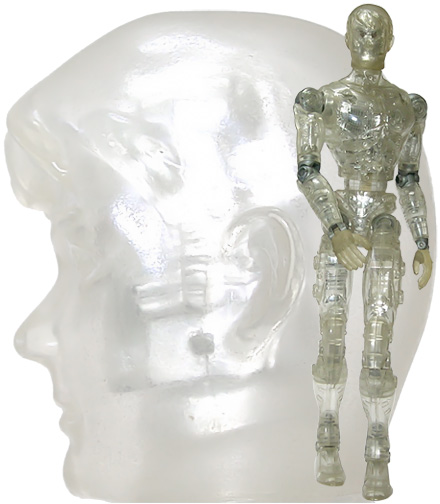Henshin Cyborg

Released in 1972, Takara’s Henshin Cyborg was arguably the line that established the Japanese toy company’s reputation as the creators of clever action figures.
Strangely enough, Henshin Cyborg owed its existence to the Vietnam War. Takara had licensed G.I. Joe from Hasbro but an action figure of an American soldier did not sell well in Japan during American interventionism in Asia. Takara, thinking fast, used the same mould to create a clear plastic figure, added some mechanical innards, created a sci-fi backstory and reaped the rewards. The toy sold like hot cakes.
Initially, however, the line seemed mostly unremarkable. The ability to transform a Henshin Cyborg figure into popular heroes of the day through costumes made it little more than a Japanese variation of Captain Action. The line earned its place in action figure history when Takara realised the removable parts, which made it easier to put on costumes, could be exploited in more imaginative ways. New parts could be attached to power-up the Cyborg or more ambitiously, transform him into a completely different toy.
Ironically, this ambitious new direction may have also resulted in Henshin Cyborg’s demise. The price of oil in the Seventies and the large scale of the line made the manufacture of vehicles and playsets costly so Takara switched focus to a new (and considerably smaller) line of action figures.
Though it lasted only a few years, Henshin Cyborg had a lasting impact. Some of the designs remain impressive even today and the line inspired the signature features of the highly influential Microman line, which would go on to greatly expand upon Henshin Cyborg’s interchangeability play pattern.
Here are a few links to get you up to speed on this classic Japanese line.
Cyborg origins.
“… Takara licensed G.I. Joe from Hasbro, but Japanese kids weren’t amused by a U.S. military hero. So Satoh backed a plan to create Henshin Cyborg, a clear-plastic doll pressed from the same injection mold. ‘We made up a crazy story about how he was an alien from the year 2025,’ Okude told me, ‘and he sold like hotcakes.'”
Japanese Wikipedia.
The Henshin Cyborg entry notes the Cyborg was first released in July ’72 while Takara Tomy’s corporate brochure claims it was released a few months later in October.
Cyber Metamorphosis.
“I established this website in order to let you know about an absolutely cool Japanese toy soldier …”
U-Ya’s photo galleries.
This essential Japanese site covers the Henshin Cyborg, Shonen Cyborg, Cyborg Jaguar, King Walder 1, Cyborg Rider, UK Cyborg and Neo Henshin Cyborg figures. (Click on the thumbnails to see detailed galleries of each type and variant.)
Henshin sets.
This fantastic Japanese page has galleries devoted not only to the 45 different Henshin Cyborg 1 costumes but also the Seigi no Mikata (lit. “Ally of Justice”) series for Takara’s New G.I. Joe figures that preceded Henshin Cyborg. (Click on the yellow arrows to see detailed views of the individual costumes.)
Denys Fisher Android, Cyborg and Muton.
“In the the mid 1970s UK toy manufacturer, Denys Fisher, produced their own range of the 8″ Shonen Cyborg toys. They changed the names of the toys from the original Android A to Android, Shonen Cyborg to Cyborg, and King Walder to Muton.”
DX Henshin Cyborg Shishioh Guy.
Japanese pictorial reviews by Transformers Baka Ichidai, Ganhoo and taku1 of the 1997 Takara GaoGaiGar figure which kick-started the brief Henshin Cyborg revival in the late 90s.
Microforever.
Paul Lorphanpaibul’s Microman site has good overviews of the original Henshin Cyborg 1 line as well as the Neo Henshin Cyborg, Cyborg 99 and X-Borg lines.
Neo Henshin Cyborg.
Rik Ruff looks at the Shishioh Guy, Neo Henshin Cyborg and Cyborg 99 figures and provides a checklist.
Neo Henshin Cyborg versus Cyborg 99.
Jim Stelling runs through the differences.
Visible Innards.
An English forum with reviews and discussion about Henshin Cyborg and related lines.
